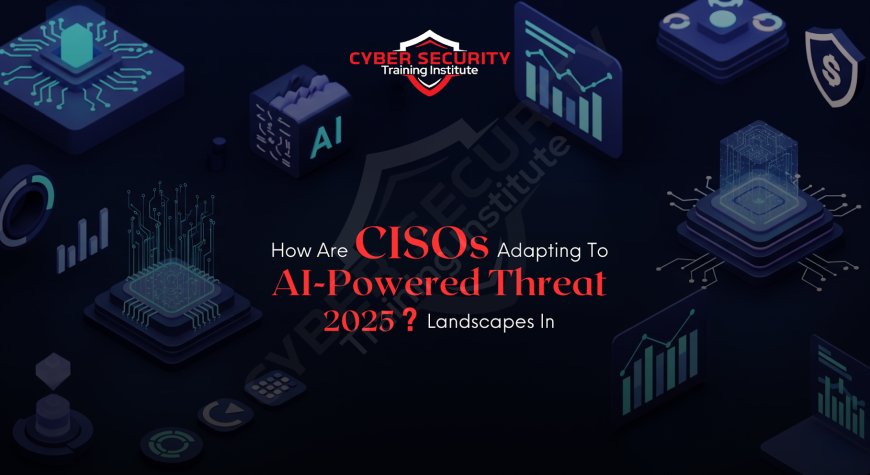How Are CISOs Adapting to AI-Powered Threat Landscapes in 2025?
CISOs are evolving their strategies to combat the rise of AI-powered cyber threats in 2025. This blog explores how they’re using AI defensively, key incidents prompting change, and the top technologies shaping security strategy. Learn how CISOs are adapting to AI-driven threat landscapes in 2025. From predictive defenses to AI-powered platforms, this blog explores the evolving role of cybersecurity leadership in today’s high-risk world.

Table of Contents
- Introduction
- The AI-Driven Threat Landscape in 2025
- Top Challenges Faced by CISOs
- Strategic Shifts in CISO Leadership
- Adopting AI for Defense
- Key Technologies Being Prioritized
- Notable Cyber Incidents Pushing Change
- Conclusion
- FAQ
Introduction
In 2025, Chief Information Security Officers (CISOs) are operating in a threat landscape dominated by AI-powered cyberattacks. With attackers leveraging machine learning, automation, and synthetic identity tools at scale, CISOs are rapidly evolving their strategies to defend critical infrastructure, safeguard sensitive data, and anticipate real-time threats.
The AI-Driven Threat Landscape in 2025
The emergence of autonomous malware, deepfake phishing, and AI-led reconnaissance has fundamentally changed how cyber threats operate. Adversaries now use generative AI to tailor attack payloads, evade detection, and conduct multi-layered attacks across networks, endpoints, and cloud environments.
Top Challenges Faced by CISOs
- Speed of Attack Evolution – AI attacks evolve in real-time, outpacing traditional detection models.
- Talent Shortage – Security teams face a critical shortage of AI-savvy professionals.
- Data Privacy Regulations – CISOs must navigate increasingly complex compliance environments.
- Supply Chain Exposure – Third-party integrations have become prime targets for AI-based intrusion.
Strategic Shifts in CISO Leadership
To combat these trends, CISOs are shifting from reactive security models to proactive, intelligence-led frameworks. The focus has moved to predictive defense, AI model governance, and cross-department collaboration. CISOs are also now integral to board-level strategy and risk management decisions.
Adopting AI for Defense
Modern CISOs are deploying AI-powered threat detection platforms that provide real-time anomaly detection, threat scoring, and behavioral analytics. These tools help detect subtle attack indicators often missed by traditional systems.
Key Technologies Being Prioritized
Here's a look at the most implemented technologies CISOs are relying on in 2025:
| Attack Name | Target | Attack Type | Estimated Impact |
|---|---|---|---|
| PhantomRecon | Cloud SaaS Providers | AI Reconnaissance Bot | €35M in data leaks |
| FinanceWorm-AI | Banking APIs | Autonomous malware | $70M financial theft |
| Synthetic Voice Phishing | Executive Teams | Deepfake Voice | Global reputational damage |
| BackdoorGPT | Source Code Repos | AI-generated malware | Widespread software tampering |
| AutoBreach Ransom | Healthcare Sector | AI ransomware | $120M in ransom payouts |
Notable Cyber Incidents Pushing Change
High-profile incidents like the BackdoorGPT compromise in open-source software and the synthetic voice CEO scam at a major multinational have forced CISOs to adopt deeper AI detection layers and invest in employee security awareness training.
Conclusion
CISOs in 2025 are no longer just IT guardians—they are AI-era strategists, building cyber resilience from boardrooms to backends. As threats continue to evolve, their success depends on how effectively they integrate AI-driven defense, promote cyber hygiene across teams, and stay ahead of the innovation curve.
FAQ
What is the biggest concern for CISOs in 2025?
AI-enabled threats that adapt in real-time are the top concern, followed by talent shortages and supply chain vulnerabilities.
How are CISOs using AI to defend systems?
CISOs are deploying machine learning-based detection tools, anomaly behavior platforms, and automated incident response systems.
What sectors are most at risk?
Finance, healthcare, government, and cloud infrastructure are among the most targeted sectors by AI-driven threats.
Are CISOs involved in boardroom decisions now?
Yes. Due to the strategic importance of cybersecurity, CISOs now play a key role in enterprise risk management at the executive level.
What tools are helping CISOs the most?
XDR platforms, AI analytics engines, threat intelligence feeds, and adaptive MFA solutions are critical for modern defense.
Is human training still important?
Absolutely. Even with AI, security awareness training for employees remains a critical line of defense against social engineering attacks.
What is synthetic voice phishing?
It’s a new attack type where AI-generated voices impersonate executives to deceive employees or partners into taking harmful actions.
Are cloud platforms more secure now?
Cloud platforms have improved, but are still a key target. CISOs focus on identity management, encryption, and AI monitoring to secure them.
Can AI backfire in defense?
Yes, poorly trained or manipulated AI models can lead to misclassification, exposing organizations to more risk.
What is the role of predictive analytics?
Predictive threat analytics helps CISOs forecast potential breaches and respond before they happen.
What's Your Reaction?
 Like
0
Like
0
 Dislike
0
Dislike
0
 Love
0
Love
0
 Funny
0
Funny
0
 Angry
0
Angry
0
 Sad
0
Sad
0
 Wow
0
Wow
0















